Thomas Fuller (architect)
Thomas Fuller (March 8, 1823 – September 28, 1898) was an English-born Canadian architect. From 1881 to 1896, he was Chief Dominion Architect for the Government of Canada, during which time he played a role in the design and construction of every major federal building.
Thomas Fuller | |
|---|---|
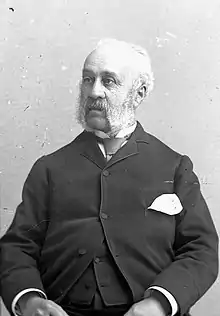 Fuller in 1889, photographed by William James Topley | |
| Born | March 8, 1823 Bath, Somerset, England |
| Died | September 28, 1898 (aged 75) Ottawa, Ontario, Canada |
| Nationality | Canadian |
| Occupation | Architect |
| Practice | Thomas Fuller & Chilion Jones Chief Dominion Architect |
Early life and education
Fuller was born on March 8, 1823, in Bath, Somerset, England, where he trained as an architect with James Wilson (becoming a pupil of Wilson's in 1844)[1] alongside his future architectural business partner William Bruce Gingell. His father, also called Thomas, was a carriage-maker, and his mother was Mary Filler (née Tiley).[2]
Career
While living in Bath and London, he did a number of architectural projects, with Wilson (with whom he went into partnership in 1854),[1] with Gingell (working as Fuller and Gingell from 1848 to 1850)[3] or on his own account. In 1845, he left for Antigua, where he spent two years working on the new St John's Cathedral, before emigrating to Canada in 1857. Settling in Toronto, he formed a partnership with Chilion Jones in which Fuller was responsible for design work. The company first won the contract to design the Church of St. Stephen-in-the-Fields in Toronto.
In 1859, the Legislative Assembly in Ottawa voted the sum of £75,000 for the erection of a "Parliament House" and offered a premium of $1000 for the best design within that budget. The winning bid was made by Fuller and Jones for a Neo-Gothic design. The principal architects until its completion in 1866 were Thomas Fuller and Charles Baillairge. In Hand Book to the Parliamentary and Departmental Buildings, Canada (1867), Joseph Bureau wrote, "The corner stone was laid with great ceremony by His Royal Highness the Prince of Wales [the future king Edward VII] in September, 1860, on which occasion the rejoicings partook of the nature of the place, the lumber arches and men being a novelty to most of its visitors, bullocks and sheep were roasted whole upon the government ground and all comers were feasted."
In 1867 he won the contract to build the New York State Capitol building in Albany, New York, and spent the next several years in the United States. The project ran into severe cost overruns and an inquiry blamed Fuller. Fuller thus returned to Canada and, unable to work in the more lucrative private sector, in 1881 became Chief Dominion Architect, succeeding Thomas Seaton Scott.
Canada's Department of Public Works erected a number of post offices in smaller urban centres during Thomas Fuller's term as Chief Architect.[4]
Works
England
| Building | Year completed | Heritage status | Builder/architect | Style | Location | Image |
|---|---|---|---|---|---|---|
| Central Block of Greenbank Prison (formerly Longfield House) | 1849 | Listed Grade II by Historic England in 2007[5] |
Architects: Fuller & Gingell (Thomas Fuller and William Bruce Gingell) Builder: William Clift |
Plymouth, Devon | ||
| Cranwells (formerly Summerfield School) Weston Park East | 1852 | Listed Grade II by Historic England in 1972.[6] | Architects: Wilson & Fuller (James Wilson and Thomas Fuller) | Bath, Somerset | ||
| Bradford-on-Avon Town Hall and police station and offices (now St Thomas More Roman Catholic Church, Bradford-on-Avon) | 1854 | Listed Grade II by Historic England in 1974 (former town hall)[7] and in 1993 (police station and offices)[8] |
Architect: Thomas Fuller Builders: Long and Spender[9] |
Elizabethan | Market Street, Bradford-on-Avon, Wiltshire |  |
| Anglican Mortuary Chapel in the churchyard of St Mary the Virgin, Bathwick (now Smallcombe Cemetery[10] | 1855 | Listed Grade II by Historic England in 2008[11][12] |
Architect: Thomas Fuller Builder: George Mann |
Early English[10] | Darlington Street, Bath, Somerset | 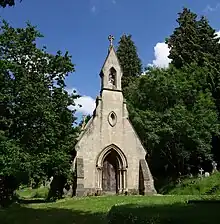 |
| Buildings at Holt Road Cemetery, Bradford-on-Avon | 1856 | Architect: Thomas Fuller[13] | Bradford-on-Avon, Wiltshire | |||
| Nos 1 and 2, Christchurch Cottages, Bath | 1856 | Listed Grade II by Historic England in 2011[14] |
Architect believed to be by Thomas Fuller[14] | Julian Road, Bath, Somerset | ||
| Newark Works | c. 1857 | Listed Grade II by Historic England in 2006.[15] The building was converted in 2022 into flexible working space for small businesses as part of the Bath Quays development.[16] Its larger site was developed from 2011 into the Bath Western Riverside residential scheme.[17] | Architect: Thomas Fuller | Lower Bristol Road, Bath, Somerset |
Wales
| Building | Year completed | Heritage status | Builder/architect | Style | Location | Image |
|---|---|---|---|---|---|---|
| Llandovery College (known until the 1880s as the Thomas Phillips Institution, or the Welsh Collegiate Institution) | 1851 | Listed Grade II by Cadw in 2004[18] | Architects: Fuller and Gingell (Thomas Fuller and William Bruce Gingell) | Tudor Gothic | Queensway, Llandovery, Carmarthenshire | .jpg.webp) |
California
| Building | Year completed | Heritage status | Builder/architect | Style | Location | Image |
|---|---|---|---|---|---|---|
| San Francisco City Hall[2] | 1899 | Destroyed in the 1906 San Francisco Earthquake | Architects: Fuller and Laver (Thomas Fuller and Augustus Laver) | Second Empire | Larkin Street, McAllister Street and the former City Hall Avenue, San Francisco | 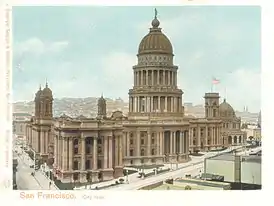 |
New York State
| Building | Year completed | Heritage status | Builder/architect | Style | Location | Image |
|---|---|---|---|---|---|---|
| Ground floor of the New York State Capitol | 1867-1875 | It was listed on the National Register of Historic Places in 1971, then included as a contributing property when the Lafayette Park Historic District was listed in 1978. The New York State Capitol was declared a National Historic Landmark in 1979.[19][20] | Architect: Thomas Fuller | Classical/Romanesque | Albany, New York | 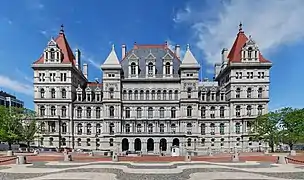 |
Alberta
| Building | Year completed | Heritage status | Builder/architect | Style | Location | Image |
|---|---|---|---|---|---|---|
| Land Titles Building – Victoria Armoury | 1893 | On Canada's Register of Historic Places since 1977[21] | Architect: Thomas Fuller | 10523 100 Avenue, Edmonton | .JPG.webp) | |
| Calgary Post Office | 1895 | Demolished in about 1929[22] | Architect: Thomas Fuller | 8th Avenue, Calgary |
British Columbia
| Building | Year completed | Heritage status | Builder/architect | Style | Location | Image |
|---|---|---|---|---|---|---|
| The Armouries (home of the The Royal Westminster Regiment) | 1895 | A Recognized Federal Heritage Building since 1987[23] | Architect: Thomas Fuller: Builder: David Bain | Italianate/ Romanesque Revival |
530 Queen's Avenue, New Westminster |
 |
Manitoba
| Building | Year completed | Heritage status | Builder/architect | Style | Location | Image |
|---|---|---|---|---|---|---|
| Former Dominion Post Office Building / Portage City Hall | 1898 | Originally a post office, it became the Portage la Prairie City Hall in 1960. A plaque erected in 1983 by the Historic Sites and Monuments Advisory Board of Canada describes it as a representative of small, urban post offices designed by Fuller, and says that is mostly intact and has not undergone major exterior renovation.[24] It was designated a National Historic Site of Canada in 1983.[25] | Architect: Thomas Fuller | Romanesque Revival | 97 Saskatchewan Avenue West, Portage la Prairie | 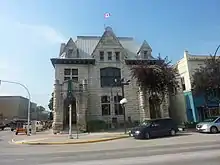 |
Nova Scotia
| Building | Year completed | Heritage status | Builder/architect | Style | Location | Image |
|---|---|---|---|---|---|---|
| Halifax Armoury | 1858 | It was designated a National Historic Site of Canada in 1989[26] and a Classified Federal Heritage Building in 1991.[27] | Architect: Thomas Fuller | Romanesque Revival | Cornwallis Street, Halifax |  |
| Gilbert H. Grosvenor Hall (originally built as the Baddeck Post Office and Custom House) | 1887 | On Canada's Register of Historic Places since 1983[28] | Architect: Thomas Fuller | Romanesque Revival | Baddeck |  |
Ontario
| Building | Year completed | Heritage status | Builder/architect | Style | Location | Image |
|---|---|---|---|---|---|---|
| St. Stephen-in-the-Fields Anglican Church | 1858 | The church was gutted by fire in 1865 and subsequently rebuilt and enlarged by Henry Langley. None of Fuller's original interior survives but, on the exterior, the polychromatic masonry, solid buttressing and open bell core survive.[29] | Architects: Fuller & Jones (Thomas Fuller and Chilion Jones); rebuilt by Henry Langley | Neo-Gothic | 103 Bellevue Avenue, Kensington Market, Toronto |  |
| Canada's Parliament Buildings Centre Block | 1858 | Destroyed by fire in 1916. in The replacement building was designed by a team of architects led by John A. Pearson and Jean-Omer Marchand. | Architects: Fuller & Jones (Thomas Fuller and Chilion Jones)[30] | Neo-Gothic | Parliament Hill, Ottawa |  |
| Library of Parliament[31] | 1858 | Architects: Fuller & Jones (Thomas Fuller and Chilion Jones) | Victorian High Gothic | Parliament Hill, Ottawa |  | |
| Langevin Block (renamed Office of the Prime Minister and Privy Council in 2017) | 1858 | The building is a National Historic Site of Canada[32] and was recognized as a Classified Federal Heritage Building in 1988.[33] | Architects: Thomas Fuller and Henry Langley | Second Empire | Parliament Hill, Ottawa | (cropped).jpg.webp) |
| Victoria Tower | 1866 | The tower was destroyed during the great fire of the Centre Block on 3 February 1916. Its replacement, the Peace Tower, was built on the same location but the design (larger clock face, ornamental High Victorian Gothic vs. simpler Modern Gothic) and height were radically changed. The original tower bore some similarities to the tower at the Parliament Building in Quebec (which is still standing). The Victoria Tower Bell is the only relic remaining from the Victoria Tower. | Architect: Thomas Fuller | Neo-Gothic | Parliament Hill, Ottawa | 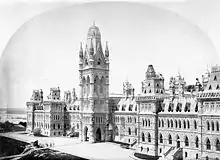 |
| Royal Military College of Canada Gatehouse 1, Building R2 | 1884 | A Recognized Federal Heritage Building 1994[34] | Architect: Thomas Fuller | Point Frederick, Kingston |  | |
| Royal Military College of Canada Gatehouse 2, Building R6 | 1884 | A Recognized Federal Heritage Building 1994[35] | Architect: Thomas Fuller | Point Frederick, Kingston | ||
| Former Brockville Post Office[36] | 1886 | Designated a National Historic Site of Canada in 1983[37] | Architect: Thomas Fuller | Flemish, Queen Anne and classical elements | 14 Court House Avenue, Brockville |  |
| Old Galt Post Office building | 1887 | Designated a National Historic Site of Canada in 1983[38] | Architect: Thomas Fuller; Builder: M.A. Piggott | Romanesque, Gothic and Second Empire | 12 Water Street South, Cambridge | 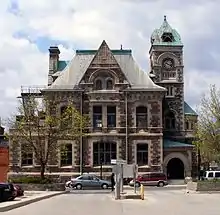 |
| Royal Military College of Canada Administration Building, former Hospital, Building 55 | 1887 | Designated a Recognized Federal Heritage Building in 1994[39] | Architect: Thomas Fuller | Classical Revival elements | 19 Valour Drive, Kingston | _(1887).jpg.webp) |
| Napanee Post Office | 1887 | A National Historic Site of Canada since 1977[40] | Architect: Thomas Fuller | Richardson Romanesque and Victorian Eclecticism | 36 Bridge Street, Greater Napanee |  |
| John Weir Foote Armoury |
1888–1908 | A National Historic Site of Canada since 1989[41] | Architects: Thomas Fuller and David Ewart | Neo-Gothic | 200 James Street North, Hamilton 43°15′42.76″N 79°51′58.42″W |
 |
| Almonte Post Office | 1891[42] | A National Historic Site of Canada since 1983[43] | Architects: Thomas Fuller and Henry Langley | Romanesque Revival | 73 Mill Street, Mississippi Mills | 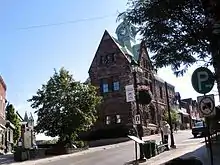 |
| Toronto Armouries | 1894 | Demolished in 1963.[44] A plaque in front of the Toronto Courthouse at University Avenue and Armoury Street marks the Armouries' site. | Architect: Thomas Fuller | Romanesque Revival | University Avenue, Toronto |  |
Prince Edward Island
| Building | Year completed | Heritage status | Builder/architect | Style | Location | Image |
|---|---|---|---|---|---|---|
| Former Summerside Post Office | 1887 | A National Historic Site of Canada since 1983[45] | Architect: Thomas Fuller | Gothic and Romanesque elements | 45 Summer Street, Summerside 46°23′36.04″N 63°47′26.32″W |
 |
Quebec
| Building | Year completed | Heritage status | Builder/architect | Style | Location | Image |
|---|---|---|---|---|---|---|
| Coaticook Post Office | 1886-1890 | A National Historic Site of Canada since 1988[46] | Architect: Thomas Fuller | 34, Rue Main Est, Coaticook |  | |
| Saint-Hyacinthe Post Office | 1892 | A National Historic Site of Canada since 1983[47] | Architect: Thomas Fuller | Italianate/ Romanesque Revival | 1915 Girouard Street West, Saint-Hyacinthe |
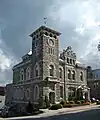 |
Saskatchewan
| Building | Year completed | Heritage status | Builder/architect | Style | Location | Image |
|---|---|---|---|---|---|---|
| Lloydminster Old Post Office | 1931 | A National Historic Site of Canada since 1981[48] | Architect: Thomas Fuller | Classical | 5001 50th Street, Lloydminster |  |
Family
In 1853 he married Caroline Anne Green, who was also from Bath; they had one son and two daughters together.[2] Their son, Thomas W. Fuller, was also an architect, being appointed Canada's Chief Architect in 1927. Thomas W. Fuller's son, Thomas G. Fuller, spent more than 50 years in the building industry.[49]
Death and legacy
Fuller died on September 28, 1898, and was interred in the Beechwood Cemetery in Ottawa.
A 35 cent, three-colour Canadian postage stamp, issued in 1980, featured an image of the Parliament Buildings and the text "Royal Canadian Academy of Arts, 1880–1980, Thomas Fuller".[50]
Several of his buildings in Bath have been threatened with demolition and other works, such as his Bradford-on-Avon Town Hall, have been converted into other uses (the Town Hall is now the St Thomas More Roman Catholic Church, Bradford-on-Avon).
In 2002, the Thomas Fuller Construction Company, founded by Fuller's grandson Thomas G. Fuller and now operated by his great-grandsons, was awarded a contract to renovate the Library of Parliament in Ottawa which he originally designed.[51]
In 2016, the Canadian government added Fuller to their list of Persons of National Historic Significance.[52]
Further reading
- Mindenhall, Dorothy (2015), Thomas Fuller: Architect for a Nation, Lakehill Books, 158 pp, 92 illustrations.[53]
References
- Orbach, Julian (March 2009). ""Wilson, James" in An index of architects, engineers, surveyors, builders, working in Wales". Julian Orbach. Retrieved 21 September 2023.
- Thomas, Christopher Alexander (2003). "Fuller, Thomas". Dictionary of Canadian Biography. University of Toronto/Université Laval. Retrieved 20 September 2023.
- Orbach, Julian (March 2009). ""Fuller, Thomas" in An index of architects, engineers, surveyors, builders, working in Wales". Julian Orbach. Retrieved 21 September 2023.
- "Thomas Fuller's Post Offices". Library and Archives Canada Blog. 17 December 2015. Retrieved 23 September 2023.
- Historic England (30 April 2008). "Central Block of Greenbank Prison (formerly Longfield House) (1392324)". National Heritage List for England. Retrieved 20 September 2023.
- Historic England (15 October 2010). "Cranwells (Formerly Summerfield School), And Attached Balustrades And Steps, Weston Park East (1395681)". National Heritage List for England. Retrieved 21 September 2023.
- Historic England (23 August 1974). "Roman Catholic Church of Sir Thomas More (1364518)". National Heritage List for England. Retrieved 14 September 2023.
- Historic England (23 August 1974). "3, and 4 Market Street (1036172)". National Heritage List for England. Retrieved 20 September 2023.
- "The Town Hall, now Catholic Church". Bradford-on-Avon Museum. Retrieved 17 September 2023.
- "The Church of England Mortuary Chapel, Smallcombe Vale". Smallcombe Garden Cemetery. Retrieved 17 September 2023.
- Historic England (9 April 2008). "Anglican Cemetery Chapel, St Mary's Churchyard, Bathwick Cemetery Road (1392521)". National Heritage List for England. Retrieved 5 September 2014.
- "Anglican Cemetery Chapel, St Mary's Churchyard, Bath". British Listed Buildings. Retrieved 5 September 2014.
- "Holt Road Cemetery, Bradford". Bradford-on-Avon Museum. 28 February 2011. Retrieved 19 September 2023.
- Historic England (2 December 2011). "Christchurch Cottages (1406355)". National Heritage List for England. Retrieved 19 September 2023.
- Historic England (15 October 2010). "Newark Works (ex Stothert and Pitt) (1395130)". National Heritage List for England. Retrieved 17 September 2023.
- Baker, Hannah (20 July 2022). "Landmark Newark Works warehouse in Bath transformed in £5m renovation". SomersetLive. Retrieved 23 September 2023.
- "Bath Western Riverside Overview". Bath Western Riverside Construction News. Crest Nicholson. Retrieved 20 July 2022.
- Cadw, "Llandovery College (Grade II) (10966)", National Historic Assets of Wales, retrieved 20 September 2023
- "New York State Capitol". National Historic Landmark summary listing. File Unit: National Register of Historic Places and National Historic Landmarks Program Records: New York, 1964 - 2013. U.S. National Archives. Retrieved 10 January 2021.
- Pitts, Carolyn (January 1979). "National Register of Historic Places Inventory-Nomination: New York State Capitol". National Park Service. Retrieved 23 August 2012. and New York State Capitol exterior undated photo; 289 KiB
- "Land Titles Building - Victoria Armouries". Canada's Historic Places. Retrieved 19 September 2023.
- Clerkin, Paul. "1895 - Post Office, Calgary, Alberta". Archiseek. Retrieved 23 September 2023.
- "Armoury: Recognized Federal Heritage Building:New Westminster, British Columbia". Parks Canada. Retrieved 19 September 2023.
- "Historic Sites of Manitoba: Dominion Post Office Building / Portage City Hall (97 Saskatchewan Avenue West, Portage la Prairie)". Manitoba Historical Society. 29 January 2022. Retrieved 23 September 2023.
- "Portage La Prairie Public Building National Historic Site of Canada". Canada's Historic Places. Retrieved 23 September 2023.
- Halifax Armoury. Canadian Register of Historic Places. Retrieved 9 February 2013.
- "Halifax Armoury". Parks Canada Directory of Federal Heritage Designations. Retrieved 17 September 2023.
- "Gilbert H. Grosvenor Hall". Canada's Historic Places. Retrieved 20 September 2023.
- "St. Stephen-in-the-Fields Anglican Church". Ontario Heritage Trust. Retrieved 22 December 2022.
- Public Works and Government Services Canada. "A Treasure to Explore > Parliament Hill > The History of Parliament Hill > Construction, 1859–1916 > Who would design it?". Queen's Printer for Canada. Archived from the original on 6 October 2011. Retrieved 1 January 2009.
- "Library of Parliament (1876)". Ontario Association of Architects. 30 January 2016. Retrieved 21 September 2023.
- Langevin Block National Historic Site of Canada. Canadian Register of Historic Places. Retrieved August 18, 2011.
- "Office of the Prime Minister and Privy Council". Canada's Historic Places. Retrieved 18 September 2023.
- "Royal Military College of Canada Building 2". Canada's Historic Places. Retrieved 29 November 2015.
- Gatehouse 2. Canadian Register of Historic Places. Retrieved 21 September 2023.
- "Designation Report: Designation Recommendation and Description, for 12 Court House Avenue Brockville, Ontario" (PDF). Heritage Brockville. 1 July 1979. Retrieved 20 September 2023.
- Former Brockville Post Office. Canadian Register of Historic Places. Retrieved 19 September 2023.
- "Former Galt Post Office National Historic Site of Canada". Canada's Historic Places. Retrieved 18 September 2023.
- "Royal Military College of Canada Building 55, Recognized Federal Heritage Building: Kingston, Ontario". Directory of Designations of National Historic Significance of Canada. Parks Canada. Retrieved 19 September 2023.
- "Napanee Post Office". Canada's Historic Places. Retrieved 21 September 2023.
- "John Weir Foote Armoury National Historic Site of Canada". Parks Canada Directory of Federal Heritage Designations. Retrieved 17 September 2023.
- "Former Almonte Post Office National Historic Site of Canada". Parks Canada. Retrieved 21 September 2023.
- "Former Almonte Post Office National Historic Site of Canada". Parks Canada. Retrieved 17 September 2023.
- "University Avenue Armouries". Toronto Historical Association]. Retrieved 21 September 2023.
- Former Summerside Post Office. Canadian Register of Historic Places. Retrieved 25 September 2011.
- Vieille poste. Canadian Register of Historic Places. Retrieved 21 September 2023.
- "Saint-Hyacinthe Post Office National Historic Site of Canada". Parks Canada. Retrieved 18 September 2023.
- "The Old Post Office". Parks Canada. Retrieved 2 October 2023.
- "Thomas Fuller Construction". Devex. Retrieved 21 September 2023.
- "Thomas Fuller, Parliament Buildings: Royal Canadian Academy of Arts, 1880-1980". Postage Stamp Guide. Retrieved 15 September 2023.
- "Edited Hansard * Table of Contents * Number 138 (Official Version)". .parl.gc.ca. Retrieved 21 October 2012.
- "Government of Canada Announces 13 New National Historic Designations". Government of Canada (Press release). 4 July 2016. Retrieved 21 September 2023.
- Kalman, Hal (27 April 2016). "Book Review: Thomas Fuller: Architect for a Nation". Spacing. Toronto and Vancouver, Canada. Retrieved 17 September 2023.
Sources
- Canada by Design: Parliament Hill, Ottawa at Library and Archives Canada
External links
- Biography at the Dictionary of Canadian Biography Online
- Thomas Fuller biography from St. Stephen-in-the-Fields
- Thomas Fuller (architect), Chief Dominion Architect 1881–1896
- Canada's Historic Places
- Family: When Simon Fuller designed and built his house at Britannia on the Bay, he drew on family traditions and on his own passion for the river to create a unique and wonderful setting for family life By Janet Uren Photography by Gordon King